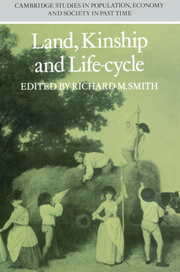Book contents
- Frontmatter
- Contents
- List of contributors
- Preface
- 1 Some issues concerning families and their property in rural England 1250–1800
- 2 Population pressure, inheritance and the land market in a fourteenth-century peasant community
- 3 Families and their land in an area of partible inheritance: Redgrave, Suffolk 1260–1320
- 4 Population changes and the transfer of customary land on a Cambridgeshire manor in the fourteenth century
- 5 Industrial employment and the rural land market 1380– 1520
- 6 Changes in the size of peasant holdings in some west midland villages 1400–1540
- 7 The erosion of the family–land bond in the late fourteenth and fifteenth centuries: a methodological note
- 8 Changes in the link between families and land in the west midlands in the fourteenth and fifteenth centuries
- 9 Kinship in an English village: Terling, Essex 1550–1700
- 10 The myth of the peasantry: family and economy in a northern parish
- 11 Poverty, poor relief and the life-cycle: some evidence from seventeenth-century Norfolk
- 12 The receipt of poor relief and family situation: Aldenham, Hertfordshire 1630–90
- 13 Widows in pre-industrial society: an essay upon their economic functions
- 14 Real property, marriage and children: the evidence from four pre-industrial communities
- 15 The nineteenth-century peasantry of Melbourn, Cambridgeshire
- Consolidated Bibliography
- Index
Preface
Published online by Cambridge University Press: 19 October 2009
- Frontmatter
- Contents
- List of contributors
- Preface
- 1 Some issues concerning families and their property in rural England 1250–1800
- 2 Population pressure, inheritance and the land market in a fourteenth-century peasant community
- 3 Families and their land in an area of partible inheritance: Redgrave, Suffolk 1260–1320
- 4 Population changes and the transfer of customary land on a Cambridgeshire manor in the fourteenth century
- 5 Industrial employment and the rural land market 1380– 1520
- 6 Changes in the size of peasant holdings in some west midland villages 1400–1540
- 7 The erosion of the family–land bond in the late fourteenth and fifteenth centuries: a methodological note
- 8 Changes in the link between families and land in the west midlands in the fourteenth and fifteenth centuries
- 9 Kinship in an English village: Terling, Essex 1550–1700
- 10 The myth of the peasantry: family and economy in a northern parish
- 11 Poverty, poor relief and the life-cycle: some evidence from seventeenth-century Norfolk
- 12 The receipt of poor relief and family situation: Aldenham, Hertfordshire 1630–90
- 13 Widows in pre-industrial society: an essay upon their economic functions
- 14 Real property, marriage and children: the evidence from four pre-industrial communities
- 15 The nineteenth-century peasantry of Melbourn, Cambridgeshire
- Consolidated Bibliography
- Index
Summary
In the era marking what some might regard as a ‘rebirth’ in studying the history of the family – inaugurated formally in 1972 by the publication of the essays in Household and Family in Past Time and extended both methodologically and geographically in Family Forms in Historic Europe – a preeminent place was reserved for the measurement of the household or the co-resident domestic group. Indeed, in the context of an emerging and increasingly ‘positivistic’ approach to social history, it was almost inevitable that the household with its tangible qualities should become the focus of attention of family historians with a commitment to the quantitative analysis of historical social structures. Yet a doubt has been frequently raised as to the status of ‘residence’ as a criterion for the analysis of the family, whether comparisons are being made over space or through time. There are nonetheless perfectly sound reasons for considering that the knot of persons who sleep and frequently, if not invariably, take meals together under the same roof constitutes a unit for social analysis, and can form a basis for revealing inter-society comparisons, particularly if due attention is given to the means by which that unit has been brought together (e.g. whether initiated by marriage or through the fission of a pre-existing group). But this mode of analysis, Michael Anderson might say, is still reminiscent of studying the ‘family in a thermos flask’, and is certainly inadequate in its interpretation of households or kin groups in the matter of the economic behaviour of their members.
- Type
- Chapter
- Information
- Land, Kinship and Life-Cycle , pp. ix - xivPublisher: Cambridge University PressPrint publication year: 1985
- 1
- Cited by



